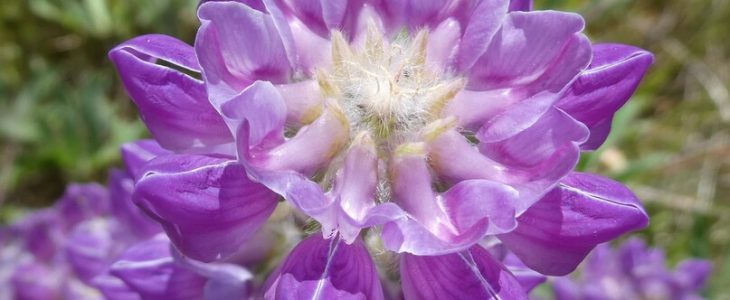
If you are drawn to plants, you may have the sometimes dubious habit of botanizing as you go. This is a wonderful pastime if you are going on foot. But if you are going by bicycle, or worse, by car it can be a hazard and any poor soul brave enough to accompany you may wonder why you suddenly swerve to pull over on narrow country lanes. I first met chick lupine Lupinus microcarpus growing along the road cuts on the way into Henry Coe State Park. Though the plant life along that road is alluring, it is a dubious place to stop for a closer look. Happily, you can also see this lovely lupine locally while safely strolling along the top of the ridge from Tilden to Wildcat Canyon Parks via the Nimitz Trail. Honing in for a better view of the details is a treat, the overall plant is densely hairy usually reaching a foot or two in height and spreading to two feet in width. The flowers are appealingly arranged in tight symmetric whorls and can range in color from white to pale yellow, magenta pink and deep purple. This annual wild flower is found in open or disturbed places below 5000 ft. throughout Western North America.
The lupines are important members of the pea family, much loved for their showy whorls of flowers in spring. California is home to over 100 species (including varieties and subspecies) of lupine. Lupine life forms range from annuals to perennials and shrubs – from the aptly named annual, miniature lupine Lupinus bicolor through shrub forms such as the coastal bush lupine Lupinus arboreus which can grow up to 5 ft. tall. Lupine flowers are composed of what we think of as typical pea blossoms each with three distinctive parts. Characteristically, the banner is the upright upper most petal, the wings run roughly perpendicular to the banner, and the lower fused petal in the shape of a boat is called the keel enclosing the flower’s reproductive parts. Lupines often live in nutrient poor either sandy or rocky soils. Nitrogen fixing nodules on their roots contain bacteria able to convert nitrogen that wouldn’t otherwise be available to the plant to a usable form. All lupines have palmately compound leaves, formed by many finger-like leaflets creating the effect of looking something like a hand. The seeds of the lupine form in a pea-pod type capsule and are of high value to herbivores. The clue to identification of the chick lupine is not the highly variable flower color but the short fuzzy pods containing only 2 seeds. In our area we are lucky to have several different species of lupine growing in the wild. Some of the best local annual wildflower displays are put on by sky lupine, arroyo lupine and chick lupine. To the mix of common locals, we may someday be able to add fleshy lupine Lupinus affinis which was recently re-discovered in the East Bay by retired landscaper and volunteer restorationist Glen Schneider. Glen found a small population of fleshy lupine “hidden in plain site along Grizzly Peak Boulevard”. His group at Skyline Gardens and the folks doing restoration in Derby Canyon are working on establishing populations in their project areas, so perhaps one day we will be able to count it as a common local as well.
In the garden, chick lupine is an attractive addition to borders or meadow plantings. It is at its best in full sun, but can take some shade or filtered light for part of the day. Chick lupine thrives in clay soils but also tolerates a range of soil types. It’s not too late to plant annuals, late planting simply extends the bloom period. This is helpful to bees and other insects depending upon the pollen and nectar in your flower beds. Once the plants begin to go dormant, keep an eye out for drying seed capsules. With lupines it is always a trick of timing to catch the pods when the seeds are ripe but the pods have not yet exploded. When cleaning up the plants that have completed their life cycle, allow seeds to fall where you would like them to grow again next winter. As an insurance policy, be sure to gather a generous handful of seed and hold it in a labeled envelope to direct sow next season, just in case the seeds that fall during clean up get eaten up by hungry ground feeding birds or mice.
Happy Spring!
Written by Kristen Hopper
Featured photo by Zoya Akulova